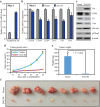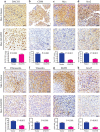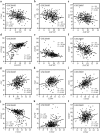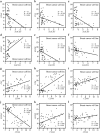DACH1 suppresses breast cancer as a negative regulator of CD44
- PMID: 28659634
- PMCID: PMC5489534
- DOI: 10.1038/s41598-017-04709-2
DACH1 suppresses breast cancer as a negative regulator of CD44
Abstract
Dachshund homolog 1 (DACH1), a key cell fate determination factor, contributes to tumorigenesis, invasion, metastasis of human breast neoplasm. However, the exact molecular mechanisms for the anti-tumor roles of DACH1 in breast carcinoma are still lack of extensive understanding. Herein, we utilized immunohistochemistry (IHC) staining and public microarray data analysis showing that DACH1 was higher in normal breast, low-grade and luminal-type cancer in comparison with breast carcinoma, high-grade and basal-like tumors respectively. Additionally, both correlation analysis of public databases of human breast carcinoma and IHC analysis of mice xenograft tumors demonstrated that DACH1 inversely related to cancer stem cells (CSCs) markers, epithelial-mesenchymal transition (EMT) inducers and basal-enriched molecules, while cluster of differentiation 44 (CD44) behaved in an opposite manner. Furthermore, mice transplanted tumor model indicated that breast cancer cells Met-1 with up-regulation of DACH1 were endowed with remarkably reduced potential of tumorigenesis. Importantly, meta-analysis of 19 Gene Expression Omnibus (GEO) databases of breast cancer implicated that patients with higher DACH1 expression had prolonged time to death, recurrence and metastasis, while CD44 was a promising biomarker predicting worse overall survival (OS) and metastasis-free survival (MFS). Collectively, our study indicated that CD44 might be a novel target of DACH1 in breast carcinoma.
Conflict of interest statement
The authors declare that they have no competing interests.
Figures







References
Publication types
MeSH terms
Substances
Grants and funding
LinkOut - more resources
Full Text Sources
Other Literature Sources
Medical
Research Materials
Miscellaneous

